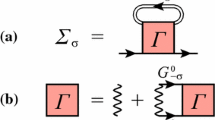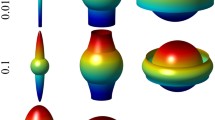Abstract
A semiclassical second-order differential equation for the inhomogeneous local gap \(\Delta (\varvec{r})\) is derived from a strict second-order \(\hbar \) expansion of the anomalous pairing tensor and compared with a similar equation given in Simonucci and Strinati (in Phys Rev B 89:054511, 2014). The second-order normal density matrix is given as well. Several extra gradient terms are revealed. Second-order expressions at finite temperature are given for the first time. The corresponding Ginzburg–Landau equation is presented and it is shown that, compared to the equation of Baranov and Petrov (in Phys Rev A 58:R801, 1998), an extra second-order gradient term is present. Applications to the pairing gap in cold atoms in a harmonic trap are discussed.




Similar content being viewed by others
Data Availability
This manuscript has no associated data or the data will not be deposited. [Authors’ comment: This article is a purely theoretical work and has no associated data.]
References
S. Simonucci, G.C. Strinati, Phys. Rev. B 89, 054511 (2014)
M.A. Baranov, D.S. Petrov, Phys. Rev. A 58, R801 (1998)
P. Ring, P. Schuck, The Nuclear Many-Body Problem. Springer 1980
P.G. De Gennes, Superconductivity of Metals and Alloys (Benjamin, New York, 1966). (chapter 5)
M. Grasso, M. Urban, Phys. Rev. A 68, 033610 (2003)
K. Taruishi and P. Schuck, Z. Phys. A 342, 3397 (1992)
C.A. Ullrich, E.K.U. Gross, Aust. J. Phys. 49, 103 (1996)
A. Csordas, O. Almásy, P. Szépfalusy, Phys. Rev. A 82, 063609 (2010)
J.C. Pei, Na Fei, Y.N. Zhang and P. Schuck, Phys. Rev. C 92, 064316 (2015)
S. Simonucci, P. Pieri, G.C. Strinati, Nat. Phys. 11, 941 (2015)
C.A.R. Sá de Melo, M. Randeria, J.R. Engelbrecht, Phys. Rev. Lett. 71, 3202 (1993)
A.L. Fetter, J.D. Walecka, Quantum Theory of Many Particle Systems (McGraw-Hill, New York, 1971)
S. Chiacchiera, T. Lepers, M. Urban, D. Davesne, Phys. Rev. A 79, 033613 (2009)
M. Urban, and P. Schuck, Phys. Rev. A 73, 013621 (2006); erratum ibid.75, 049903 (2007)
M. Urban, P. Schuck, Phys. Rev. A 78, 011601(R) (2008)
M. Marini, F. Pistolesi, G.C. Strinati, Eur. Phys. J. B 1, 151 (1998)
M. Abramowitz, I.A. Stegun, Handbook of Mathematical Functions (Dover, New York, 1972). (chapter 17)
I.S. Gradshteyn and I.M. Ryzhik, Tables of Integral, Series and Products (Academic Press, New York, 1965) section 8.1
Acknowledgements
We are very greatful to G. C. Strinati who introduced us to many details of the derivation of the formulas in [1]. One of us, X.V., was partially supported by Grants No. FIS2017-87534-P from MINECO and No. CEX2019-000918-M from AEI-MICINN through the “Unit of Excellence María de Maeztu 2020-2023” award to ICCUB.
Author information
Authors and Affiliations
Corresponding authors
Additional information
Communicated by David Blaschke.
Appendices
A Explicit expressions for the \(Y^\kappa _i\) and \(Y^\rho _i\) coefficients at \(T=0\)
As we have mentioned in the main text, the \(\varvec{p}\) integrals of the pair and normal density matrices (6) and (9) can be performed analytically at zero temperature. However, it will turn out that there are certain terms which are divergent in the limit \(\Delta \rightarrow 0\). We report here the corresponding values \(Y^\kappa _i\) as they are obtained from Pei (including all divergent terms) [9].
The functions \(Y^\kappa _i\) and \(Y^\rho _i\) can be expressed in terms of two functions \(I_5(x_0)\) and \(I_6(x_0)\), where \(x_0=\mu (\varvec{r})/\Delta (\varvec{r})\), which in turn can be written in terms of two complete elliptic integrals as follows [1, 16]:
where \(x_1^2 = (\sqrt{1 + x_0^2} + x_0)/2\) and \(\kappa ^2=x_1^2/\sqrt{1+x_0^2}\), while \(F(\pi /2,\kappa )\) and \(E(\pi /2,\kappa )\) are the complete elliptic integrals of first and second kind defined by [17, 18]
with \(\kappa ^2 < 1\). The main properties of these elliptic integrals are given in appendix A of [16].
If we write for brevity \(I_5\) and \(I_6\) for \(I_5(x_0)\) and \(I_6(x_0)\), respectively, the analytical expressions for the \(Y^\kappa _i\) functions read
In our study of the pairing in finite systems it is actually relevant to know the \(\Delta \rightarrow 0\) limit because the gap goes to zero at the surface. In this case the auxiliary functions \(I_5(x_0)\) and \(I_6(x_0)\) behave as \(I_5(x_0) \simeq \sqrt{x_0} \simeq 1/\sqrt{\Delta }\) and \(I_6(x_0)\simeq \ln (8x_0)/(2 \sqrt{x_0}) \simeq \sqrt{\Delta }\ln \Delta \), respectively [16]. This implies that, as already mentioned, in the limit \(\Delta \rightarrow 0\) some of the \(Y^\kappa _i\) functions defined previously are divergent. For example, in the function \(Y^\kappa _1\) (36) the leading term in this limit behaves as \(\nabla ^2 \Delta /\Delta ^2\) and therefore diverges.
It is easy to show that the \(\hbar ^0\) (Thomas-Fermi) contribution to the normal density in the presence of the pairing field is given by [1, 16]
The contributions to the \(\hbar ^2\) corrections of the normal density \(\rho _2\) as given in Pei [9] read
In the \(\Delta \rightarrow 0\) limit, only the \(Y^\rho _3\), \(Y^\rho _4\), \(Y^\rho _5\), \(Y^\rho _6\), and \(Y^\rho _8\) terms in \(\rho _2(\varvec{r})\) survive, because the others are multiplied by gradients of \(\Delta \). If we furthermore consider \(m^* = m\), only \(Y^\rho _3\) and \(Y^\rho _4\) are relevant. Taking into account the asymptotic behaviour of \(I_5(x_0)\) and \(I_6(x_0)\) in the limit \(\Delta \rightarrow 0\), the normal density in this case agrees with the well-known normal density given by Eq. (13.44) of Ref. [3].
B \(2\times 2\) generalized density matrix from Ref. [6]
The finite temperature expressions of section 2 can be straightforwardly derived from Eqs. (5.5) and (5.7) of [6]. The zeroth order of the \(2\times 2\) generalized density matrix is given by
Proceeding with the expression (5.7) in [6] in the same way, we obtain
where
Finally, this leads to Eqs. (6) and (9) of the main text with the \(g_i\) expressed in terms of the \(f_i\) given in [6]. Please notice that in [6] there is a sign misprint and \(g_2\) should be replaced by \(-g_2\) there.
Rights and permissions
Springer Nature or its licensor (e.g. a society or other partner) holds exclusive rights to this article under a publishing agreement with the author(s) or other rightsholder(s); author self-archiving of the accepted manuscript version of this article is solely governed by the terms of such publishing agreement and applicable law.
About this article
Cite this article
Schuck, P., Urban, M. & Viñas, X. Corrections to local-density approximation for superfluid trapped fermionic atoms from the Wigner-Kirkwood \(\hbar \) expansion. Eur. Phys. J. A 59, 164 (2023). https://doi.org/10.1140/epja/s10050-023-01077-6
Received:
Accepted:
Published:
DOI: https://doi.org/10.1140/epja/s10050-023-01077-6




